- Accueil
- Pages cachées
- 12 NOVEMBRE 2023 NEWS
12 NOVEMBRE 2023 NEWS
INSTITUT SUPERIEUR D'ANTHROPOLOGIE
INSTITUT OF ANTHROPOLOGY
COURS ONLINE – COURS A DISTANCE
INSCRIPTIONS OUVERTES
REGISTER NOW
INDE –  Sattari - In a startling discovery, a horticulturist from Nanora-Sattari Vishnu Joshi discovered hundreds of copper coins suspected to be from the seventeenth century Portuguese era in his cashew orchard on Wednesday. According to Joshi, the copper coins numbering 826 were stored in an earthen pot. He said, he accidently found these copper coins when he was engaged in cleaning work at his cashew orchard. A preliminary estimate done by the State Archives and Archeology department officials, the coins could be as old as from the 17th century. The Archives and Archeology officials say the coins could throw up more details of the trade and economy of the times in Portuguese ruled Goa of the time.
Sattari - In a startling discovery, a horticulturist from Nanora-Sattari Vishnu Joshi discovered hundreds of copper coins suspected to be from the seventeenth century Portuguese era in his cashew orchard on Wednesday. According to Joshi, the copper coins numbering 826 were stored in an earthen pot. He said, he accidently found these copper coins when he was engaged in cleaning work at his cashew orchard. A preliminary estimate done by the State Archives and Archeology department officials, the coins could be as old as from the 17th century. The Archives and Archeology officials say the coins could throw up more details of the trade and economy of the times in Portuguese ruled Goa of the time.
Goa: Portuguese Era Copper Coins Found In Sattari (freepressjournal.in)
SRI LANKA - Dimbulagala -The Polonnaruwa Archeology Office says that the largest stone inscription found in Sri Lanka so far, has been discovered. The discovery was made by officers attached to the Inscriptions Section of the Archeology Department Head Office and the Polonnaruwa Archaeological Survey Team. The stone inscription is about 45 feet long and 18 feet high. Archeology officials have already started documenting the artifact before, reports say.
ECOSSE –  – Argyl - An archaeological excavation in Argyll has unearthed new discoveries which could date back as far as 5,000 years. The 12 day dig took place at at Glendaruel’s Stronafian Community Forest in Cowal which is rich with Bronze Age and Neolithic sites A piece of pottery believed to be either Bronze Age or Neolithic in date was discovered. ‘At Creag Liath sufficient evidence was found to suggest human occupation during past explorations,’ said Andrew Jepson of Archaeology Scotland led the dig ‘This year’s dig started with the re-opening and extending of Trench 1 which had previously been located over a possible stone wall. ‘An upright stone of considerable size was found in the trench with its presence and function triggering much debate. ‘The most exciting was two small sherds of reddish-brown gritty ware, identified as a rim and believed to be either Bronze Age or Neolithic in date. Further analysis needs to be conducted on the sherds to provide a clearer provenance.
– Argyl - An archaeological excavation in Argyll has unearthed new discoveries which could date back as far as 5,000 years. The 12 day dig took place at at Glendaruel’s Stronafian Community Forest in Cowal which is rich with Bronze Age and Neolithic sites A piece of pottery believed to be either Bronze Age or Neolithic in date was discovered. ‘At Creag Liath sufficient evidence was found to suggest human occupation during past explorations,’ said Andrew Jepson of Archaeology Scotland led the dig ‘This year’s dig started with the re-opening and extending of Trench 1 which had previously been located over a possible stone wall. ‘An upright stone of considerable size was found in the trench with its presence and function triggering much debate. ‘The most exciting was two small sherds of reddish-brown gritty ware, identified as a rim and believed to be either Bronze Age or Neolithic in date. Further analysis needs to be conducted on the sherds to provide a clearer provenance.
Archaeological dig in Argyll unearths discoveries dating back 5,000 years - Scottish Field
CHINE - Xianyang -. A total of 237 tombs from about 2,000 years ago were discovered in Shaanxi Province, northwest China, said local archaeologists.The tombs, from the late Warring States Period (475 BC-221 BC), were found on the outskirts of Xianyang City. They were about 11 kilometers from ruins of a Qin kingdom palace. At the site archaeologists also found 13 tombs from the Han Dynasty (202 BC-AD 220), three from the Tang Dynasty (618-907), one from the Northern Song Dynasty (960-1127), two from the Ming Dynasty (1368-1644), and seven from the Qing Dynasty (1644-1911), as well as ruins of four Tang Dynasty kilns. A total of 878 cultural relics were unearthed, including bronzeware, jade articles, stone objects, iron pieces, and pottery. Archaeologists have excavated 805 tombs between 1995 and 2022 near this cluster, 95 percent of which were dated to the late Warring States Period, according to the Xianyang institute of cultural relics and archaeology. The two clusters were close enough in space and time to form a large graveyard of civilians, which supports the proposal that the eastern suburb of Xianyang City some 2,000 years ago was a burial site. ■
2,000-year-old tombs discovered in northwest China-Xinhua (news.c
PEROU – Arequipa -The possible living face of Peru's most famous mummy, a teenage Inca girl sacrificed in a ritual more than 500 years ago atop the Andes, was unveiled last week. The silicone-made bust portrays a young woman with pronounced cheekbones, black eyes and tanned skin. The reconstruction of the face of a young woman who was found frozen and mummified near the summit of Mount Ampato in the Peruvian Andes after being sacrificed in a ritual more than 500 years ago, in Arequipa, Peru. The job was done by a team of Peruvian and Polish archeologists and a Swedish sculptor who specialized in facial reconstruction. According to anthropological studies, Juanita was sacrificed between A.D. 1440 and 1450, when she was between 13 and 15 years old. She was 1.40 meters (55 inches) tall, weighed 35 kilos (77 pounds) and was well nourished. The probable cause of death was a severe blow to the right occipital lobe, according to researchers at Johns Hopkins University who performed a CT scan. Reinhard, who has uncovered more than 14 Inca human sacrifices high in the Andes, including three children in an icy pit at Argentina's Llullaillaco volcano, said scientists have been investigating aspects of Juanita's life, such as her diet and the objects found next to her.
Arequipa -The possible living face of Peru's most famous mummy, a teenage Inca girl sacrificed in a ritual more than 500 years ago atop the Andes, was unveiled last week. The silicone-made bust portrays a young woman with pronounced cheekbones, black eyes and tanned skin. The reconstruction of the face of a young woman who was found frozen and mummified near the summit of Mount Ampato in the Peruvian Andes after being sacrificed in a ritual more than 500 years ago, in Arequipa, Peru. The job was done by a team of Peruvian and Polish archeologists and a Swedish sculptor who specialized in facial reconstruction. According to anthropological studies, Juanita was sacrificed between A.D. 1440 and 1450, when she was between 13 and 15 years old. She was 1.40 meters (55 inches) tall, weighed 35 kilos (77 pounds) and was well nourished. The probable cause of death was a severe blow to the right occipital lobe, according to researchers at Johns Hopkins University who performed a CT scan. Reinhard, who has uncovered more than 14 Inca human sacrifices high in the Andes, including three children in an icy pit at Argentina's Llullaillaco volcano, said scientists have been investigating aspects of Juanita's life, such as her diet and the objects found next to her.
Scientists Reconstruct the Face of Peru’s 500-Year Old ‘Inca Ice Maiden’ - The Messenger
TURQUIE –  Kültepe - Excavations conducted ten years ago at the archaeological site of Kültepe Kanesh Karum, which dates back 6,000 years and is home to Anatolia’s earliest written tablets, revealed hazelnut shells consumed by the Assyrians 4,000 years ago. Until the study by Associate Professor Kahraman Gürcan from Erciyes University in Kayseri, it was believed that the 4,000-year-old hazelnut had European origins. However, Kahraman Gürcan’s 10-year DNA study indicated a different origin. Gürcan examined the hazelnut trees in Kayseri. Through a decade-long study, Gürcan revealed the DNA of the Kayseri hazelnut. Gürcan, who studies fruit genetics and breeding at Erciyes University (ERÜ) Genome and Stem Cell Center, compared the DNA structure of hazelnuts he took from many countries in the Black Sea and Europe with the samples he took from hazelnut trees in Kayseri. After Gürcan’s study, it was revealed that the DNA structure of the hazelnut trees growing in the city with a continental climate resembles neither the Black Sea nor the European type hazelnut species, and is a species unique to Kayseri.
Kültepe - Excavations conducted ten years ago at the archaeological site of Kültepe Kanesh Karum, which dates back 6,000 years and is home to Anatolia’s earliest written tablets, revealed hazelnut shells consumed by the Assyrians 4,000 years ago. Until the study by Associate Professor Kahraman Gürcan from Erciyes University in Kayseri, it was believed that the 4,000-year-old hazelnut had European origins. However, Kahraman Gürcan’s 10-year DNA study indicated a different origin. Gürcan examined the hazelnut trees in Kayseri. Through a decade-long study, Gürcan revealed the DNA of the Kayseri hazelnut. Gürcan, who studies fruit genetics and breeding at Erciyes University (ERÜ) Genome and Stem Cell Center, compared the DNA structure of hazelnuts he took from many countries in the Black Sea and Europe with the samples he took from hazelnut trees in Kayseri. After Gürcan’s study, it was revealed that the DNA structure of the hazelnut trees growing in the city with a continental climate resembles neither the Black Sea nor the European type hazelnut species, and is a species unique to Kayseri.
The DNA of 4000-years-old hazelnut shells found in Kültepe - Arkeonews
NORVEGE – 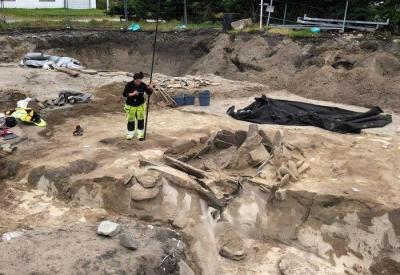 Vestkapp in Selje - Archaeologists report an extremely important 4,000-year-old stone box grave has been unearthed in Western Norway, describing it as the most unique Stone Age find in Norway in the last 100 years. This significant find, which archaeologists believe will provide information about how agriculture came to Western Norway, was discovered south of Vestkapp in Selje, Vestland. The grave is four meters long and over two meters wide. The grave is a ‘hellekistegrave’, or stone box grave, a type of burial site that has previously only been found in Buskerud, Østfold, and Denmark, but never in Western Norway. Such a grave’s finding here is noteworthy and may help explain when agriculture, which first appeared in Norway circa 3950 BC, made its way to Western Norway.
Vestkapp in Selje - Archaeologists report an extremely important 4,000-year-old stone box grave has been unearthed in Western Norway, describing it as the most unique Stone Age find in Norway in the last 100 years. This significant find, which archaeologists believe will provide information about how agriculture came to Western Norway, was discovered south of Vestkapp in Selje, Vestland. The grave is four meters long and over two meters wide. The grave is a ‘hellekistegrave’, or stone box grave, a type of burial site that has previously only been found in Buskerud, Østfold, and Denmark, but never in Western Norway. Such a grave’s finding here is noteworthy and may help explain when agriculture, which first appeared in Norway circa 3950 BC, made its way to Western Norway.
The exciting discovery of a 4000-year-old stone box grave in western Norway - Arkeonews
TURQUIE –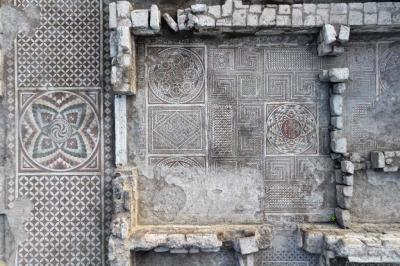
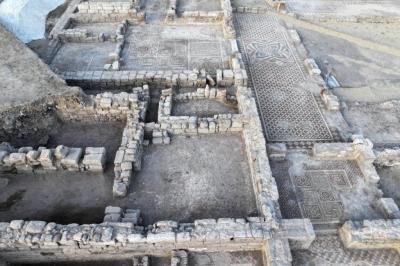
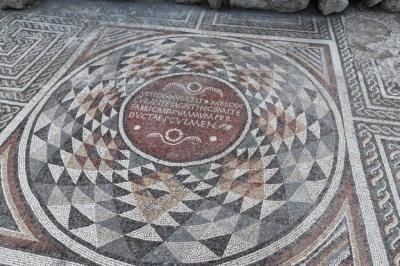 Örenşehir - The structure with the largest floor mosaic in Cappadocia and Central Anatolia Region was unearthed during the excavations carried out in Örenşehir District of İncesu district of Kayseri province, located in the center of Türkiye. During ongoing excavations, new mosaics were unearthed from the villa, which is estimated to have been built in the 4th century. Kayseri Provincial Director of Culture and Tourism, Şükrü Dursun, stated that the excavation began three years ago and that “the structure is expanding every year.” The initial assessment of the mosaic area, which was 300 square meters, has now reached up to 600 square meters.” “In the area identified as the reception hall, a Latin inscription was found. In addition to that, Greek inscriptions were also uncovered. Geometrically decorated mosaics are predominantly present here. We have reached the end of our excavations for this year. Hopefully, our work will continue next year.” The excavation director, Can Erpek stated that the structure continued to be used during the Byzantine period and after the Turks came to Anatolia. He said, “This place has approximately 33 rooms, spread over a very large area, and is a high-level residence. We have not yet fully reached the boundaries of this residence. It has highly valuable floor mosaics. In the Central Anatolia Region, which includes the Cappadocia region, we do not see such a large residence with floor mosaics. In Cappadocia, during the Roman and Byzantine periods, we generally know about imperial properties. Here, we have encountered the name ‘Hyacinthos’ in the inscriptions. We consider this name to belong to an administrator. When the data becomes clearer, we can more confidently say that it was the residence of an important figure serving in imperial property.”
Örenşehir - The structure with the largest floor mosaic in Cappadocia and Central Anatolia Region was unearthed during the excavations carried out in Örenşehir District of İncesu district of Kayseri province, located in the center of Türkiye. During ongoing excavations, new mosaics were unearthed from the villa, which is estimated to have been built in the 4th century. Kayseri Provincial Director of Culture and Tourism, Şükrü Dursun, stated that the excavation began three years ago and that “the structure is expanding every year.” The initial assessment of the mosaic area, which was 300 square meters, has now reached up to 600 square meters.” “In the area identified as the reception hall, a Latin inscription was found. In addition to that, Greek inscriptions were also uncovered. Geometrically decorated mosaics are predominantly present here. We have reached the end of our excavations for this year. Hopefully, our work will continue next year.” The excavation director, Can Erpek stated that the structure continued to be used during the Byzantine period and after the Turks came to Anatolia. He said, “This place has approximately 33 rooms, spread over a very large area, and is a high-level residence. We have not yet fully reached the boundaries of this residence. It has highly valuable floor mosaics. In the Central Anatolia Region, which includes the Cappadocia region, we do not see such a large residence with floor mosaics. In Cappadocia, during the Roman and Byzantine periods, we generally know about imperial properties. Here, we have encountered the name ‘Hyacinthos’ in the inscriptions. We consider this name to belong to an administrator. When the data becomes clearer, we can more confidently say that it was the residence of an important figure serving in imperial property.”
CHINE – 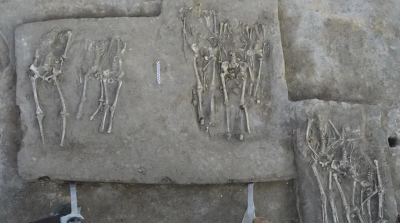
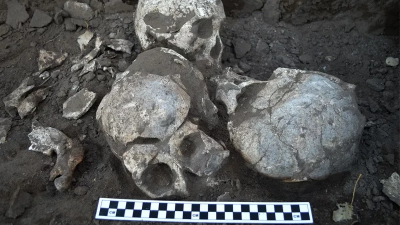 Honghe - In China, researchers discovered a mass grave containing 41 headless skeletons. The Honghe site grave contains the largest known Neolithic Chinese headhunting massacre. Thrity-two individuals appear to have been killed during the same event. Since its initial discovery in the 1990s, the gruesome site has been the subject of six different excavations. In the most recent, researchers discovered 68 skeletons in two houses and three tombs, including 41 without heads. The bodies are 4,100 to 4,400 years old. In addition, the team also found the skulls of four men in a pit outside the house and several bone tools buried alongside the skeletons. Unusually, all the victims were women or children. Every skeleton has cut marks across the neck vertebrae and several have V- and U-shaped cuts on the second vertebra. The assailants used bone-handled knives with stone blades. The similarity of these markings suggests that the killings were part of the same attack. These cutting tools were likely bone-handled instruments with stone blades, consistent with findings in the Honghe area, paralleling the same technique across the board in the perpetrator’s techniques and weapons. They indicate “the presence of a conscious head-hunting behavior”. The study, published in the Archaeological and Anthropological Sciences journal, employed visual inspections and imaging techniques to identify signs of decapitation. The researchers found that 32 of the 41 beheadings had occurred in a single event! Headhunting was a common practice in many Asian countries, particularly in Southeast Asia and the Pacific Islands. Headhunting was frequently motivated in this context by a combination of ritualistic, social, and territorial factors. Tribes and indigenous groups used headhunting to gain spiritual power, demonstrate dominance over rival communities, and appease ancestral spirits. The study speculates on two possibilities for the beheadings. Their first theory is that it was a ritual. It’s possible that when rivals attacked the settlement, they targeted women and children, resulting in an “interpersonal conflict with a high level of cruelty,” the researchers wrote in the study. It’s also possible that interlopers used a “ritual of selective decapitation” when choosing their victims, the team wrote. “Heads of enemy tribes were sought after for a specific ritual meaning, to conquer and/or possess the soul and energy of the enemies,” Qian Wang, co-author of the recent study, told LiveScience. This specific ritual might have required the heads of women and children. The second theory involved settlement rivalry. The site had three defensive trenches around it, suggesting there was a conflict between the Honghe people and other communities. The vast majority of those living at Honghe would have been farmers, fishers, and hunters. By choosing women and children as victims, a rival group would have caused the most outrage because of the “high level of cruelty.” In this scenario, the attackers took the heads as trophies. The researchers suggest that the men may have been away working during the attack and returned to find the massacred bodies of their loved ones. They then chose to bury them in the houses before abandoning the settlement. Meanwhile, researchers believe that the four skulls found in the pit may be “trophies” brought by members of the Honghe settlement from another enemy tribe.
Honghe - In China, researchers discovered a mass grave containing 41 headless skeletons. The Honghe site grave contains the largest known Neolithic Chinese headhunting massacre. Thrity-two individuals appear to have been killed during the same event. Since its initial discovery in the 1990s, the gruesome site has been the subject of six different excavations. In the most recent, researchers discovered 68 skeletons in two houses and three tombs, including 41 without heads. The bodies are 4,100 to 4,400 years old. In addition, the team also found the skulls of four men in a pit outside the house and several bone tools buried alongside the skeletons. Unusually, all the victims were women or children. Every skeleton has cut marks across the neck vertebrae and several have V- and U-shaped cuts on the second vertebra. The assailants used bone-handled knives with stone blades. The similarity of these markings suggests that the killings were part of the same attack. These cutting tools were likely bone-handled instruments with stone blades, consistent with findings in the Honghe area, paralleling the same technique across the board in the perpetrator’s techniques and weapons. They indicate “the presence of a conscious head-hunting behavior”. The study, published in the Archaeological and Anthropological Sciences journal, employed visual inspections and imaging techniques to identify signs of decapitation. The researchers found that 32 of the 41 beheadings had occurred in a single event! Headhunting was a common practice in many Asian countries, particularly in Southeast Asia and the Pacific Islands. Headhunting was frequently motivated in this context by a combination of ritualistic, social, and territorial factors. Tribes and indigenous groups used headhunting to gain spiritual power, demonstrate dominance over rival communities, and appease ancestral spirits. The study speculates on two possibilities for the beheadings. Their first theory is that it was a ritual. It’s possible that when rivals attacked the settlement, they targeted women and children, resulting in an “interpersonal conflict with a high level of cruelty,” the researchers wrote in the study. It’s also possible that interlopers used a “ritual of selective decapitation” when choosing their victims, the team wrote. “Heads of enemy tribes were sought after for a specific ritual meaning, to conquer and/or possess the soul and energy of the enemies,” Qian Wang, co-author of the recent study, told LiveScience. This specific ritual might have required the heads of women and children. The second theory involved settlement rivalry. The site had three defensive trenches around it, suggesting there was a conflict between the Honghe people and other communities. The vast majority of those living at Honghe would have been farmers, fishers, and hunters. By choosing women and children as victims, a rival group would have caused the most outrage because of the “high level of cruelty.” In this scenario, the attackers took the heads as trophies. The researchers suggest that the men may have been away working during the attack and returned to find the massacred bodies of their loved ones. They then chose to bury them in the houses before abandoning the settlement. Meanwhile, researchers believe that the four skulls found in the pit may be “trophies” brought by members of the Honghe settlement from another enemy tribe.
Largest Headhunting Massacre of Women and Children in Neolithic China - Arkeonews
IRAQ – 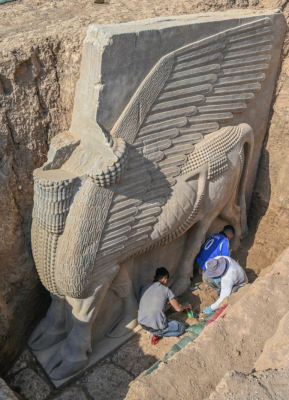
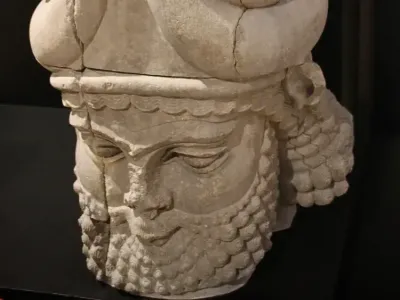 Khorsabad - The 2,700-year-old lamassu—a protective deity—had been excavated previously, in 1992, but was reburied for its protection A re-excavation of an Assyrian lamassu at the site of the ancient city of Khursbad in northern Iraq has caused a flurry of excitement in archaeological circles. In a press release yesterday, the Iraqi State Board of Antiquities and Heritage (SBAH) announced that the 2,700-year-old lamassu—an Assyrian protective deity typically possessing a human-like head, a body resembling that of a bull or lion, and wings like a bird—was relatively intact despite its substantial dimensions. The 18-tonne alabaster sculpture measures 3.8m by 3.9m (around 12.5ft by 12.8ft). The statue was commissioned for Khursbad, which was constructed by Assyrian King Sargon II as a new capital after he ascended the throne in 721BC. However following his death his son Sennacherib moved the capital to Nineveh, abandoning Khursbad. The site was rediscovered by French archaelogist Paul Emile Botta in 1842. According to the SBAH release, the lamassu was first unearthed in 1992, two years after an economically crippling UN embargo was imposed on Iraq following Saddam Hussein’s invasion of Kuwait. It was found during excavations undertaken by an Iraqi archaeological mission at Khursbad's sixth gate, on the western side of the site. As sanctions eroded the Iraqi state, antiquities thefts increased, and in 1995, the head of the statue was broken from the body and stolen by thieves. It was recovered and restored by authorities and currently sits in the Iraqi Museum in Baghdad, with cracks from its dismemberment still visible. The rest of the statue was reburied for its protection and left due to lack of funding and post-invasion turmoil. This situation saved it from the fate of the many similar objects once housed at Mosul Museum, which were destroyed in an attack by the so-called Islamic State (Isis) in 2015.
Khorsabad - The 2,700-year-old lamassu—a protective deity—had been excavated previously, in 1992, but was reburied for its protection A re-excavation of an Assyrian lamassu at the site of the ancient city of Khursbad in northern Iraq has caused a flurry of excitement in archaeological circles. In a press release yesterday, the Iraqi State Board of Antiquities and Heritage (SBAH) announced that the 2,700-year-old lamassu—an Assyrian protective deity typically possessing a human-like head, a body resembling that of a bull or lion, and wings like a bird—was relatively intact despite its substantial dimensions. The 18-tonne alabaster sculpture measures 3.8m by 3.9m (around 12.5ft by 12.8ft). The statue was commissioned for Khursbad, which was constructed by Assyrian King Sargon II as a new capital after he ascended the throne in 721BC. However following his death his son Sennacherib moved the capital to Nineveh, abandoning Khursbad. The site was rediscovered by French archaelogist Paul Emile Botta in 1842. According to the SBAH release, the lamassu was first unearthed in 1992, two years after an economically crippling UN embargo was imposed on Iraq following Saddam Hussein’s invasion of Kuwait. It was found during excavations undertaken by an Iraqi archaeological mission at Khursbad's sixth gate, on the western side of the site. As sanctions eroded the Iraqi state, antiquities thefts increased, and in 1995, the head of the statue was broken from the body and stolen by thieves. It was recovered and restored by authorities and currently sits in the Iraqi Museum in Baghdad, with cracks from its dismemberment still visible. The rest of the statue was reburied for its protection and left due to lack of funding and post-invasion turmoil. This situation saved it from the fate of the many similar objects once housed at Mosul Museum, which were destroyed in an attack by the so-called Islamic State (Isis) in 2015.
CHINE – Xi'an – An ancient collection of chariots has been uncovered in China, dating back over 2,000 years. The chariots were found near the Chinese city of Xi'an, in one of the tombs of the mausoleum of China's first emperor Qin Shi Huang, and included a rare six-sheep carriage. While the body of the chariot was not preserved after all these years, the bones of six sheep were found lined up in a row, with accessories used to pull a chariot lying on top. This led the archaeologists to suspect this was the remains of an "exceptionally rare" sheep-drawn carriage, Jiang Wenxiao, head of the tomb's archaeological excavations, said at the fourth China Archaeological Congress, according to state-owned news website China Daily. While carriages pulled by horses or ox were commonplace in ancient China, those drawn by sheep were a very rare sight and, therefore, an uncommon find. Sheep-drawn chariots are said to have been ridden by Emperor Wu, or Sima Yan, of the Western Jin Dynasty, who ruled between 266 and 290 A.D. He is believed to have ridden a sheep-drawn carriage around his palace every night, sleeping wherever the sheep came to a halt. Until now, Emperor Wu was the oldest reported occurrence of sheep-drawn chariots in history. However, this discovery in the mausoleum of Qin Shi Huang, who ruled between 221 and 210 B.C., marks the earliest discovery of this type of carriage. The archeology team hopes that doing laboratory analysis on the burial, which is currently underway, will help them determine who was buried there, the report said. At the same site, the archaeologists uncovered a number of other wooden horse-drawn chariots, aswell as an ornate wooden umbrella and several iron tools and copper weapons, according to the South China Morning Post. These are also thought to date back to the Qin dynasty. Previous discoveries in this same tomb include an ancient silver camel figurine, which was the earliest of its type found in China and suggested that the country had already begun to trade with the Middle East and West Asia.
VIDEO = 'Exceptionally Rare' Sheep Chariot Found Near Tomb of China's First Emperor (newsweek.com)



